#cossack numbers
Explore tagged Tumblr posts
Text






This is an abandoned comic that I think I did in December of last year. I couldn't continue due to lack of will and ideas.
Pharaoh Man was supposed to be the protagonist of the comic but I didn't really know what the "loyal subject" was supposed to do. It was difficult and unpredictable to make this comic because I tried to do it without writing a script.
As I wasn't going to finish it anyway, I decided to post it incomplete.
Btw Enjoy the funny faces of Pharaoh Man's helmet snake :)
#megaman#rockman#megacomics#cossack numbers#kalinka cossack#pharaoh man#skull man#toad man#dust man#ring man
384 notes
·
View notes
Note
Get Equipped with!: Trying your best


"Toadman is my friend. I like him. I think you two would get along (probably? I hope)."
1 note
·
View note
Text
so there's a lot of rhetoric around delegitimising jewsih people as the primary target of the holocaust if not outright removing them from the conversation. there's a plethora of reasons but one thats being overlooked is russia.
state sponsored troll farms have been pushing narratives in order to push attention away from their actions in ukraine, syria and the sahel. when it comes to the holocaust it goes back to the soviet era propaganda about the Great Patriotic War which is what the soviets called world war two. it was taught in school books that slavs were the true target of the holocaust because 24 million soviets died during world war two which if you just look at raw numbers will absolutely appeal to the various flavours of tankies and antisemites (tho that venn diagram is nearly a perfect circle).
the problem with this as a historical fact is its largely fabricated to feed russian nationalism. firstly many of the soviets sent to concentration camps were from conquered territories like ukraine and were sent because they were jewish, not slavic. secondly the vast majority of deaths on the soviet side were due to colossal failures in command essentially throwing soldiers to their deaths, starving civilians to the bone and utter disregard for logistics. thirdly the underpinning of the 24 million slav deaths is ignore the ethnic diversity of the soviet union and ultimately push the narrative that it was mostly russians who suffered in ww2. cossacks, chechyens, ingush, siberians, everyone suddenly became soviet which meant slav which meant as head of the republics they were then renamed as russians.
they all became russian to the nationalist history. all so russia can claim to be the ones who defeated the nazis while the satellite states sat on their hands. which justifies russian invasion in order to 'save' the baltics and eastern europe and ultimately russian control because the locals couldn't be trusted to do it right.
lastly the whole point of the holocaust was the eliminate the jewish people and anyone the nazis blamed them for corrupting, lgbt people were a jewish plot to pervert the family order, the communists were a jewish plot to take over the world (even tho the soviets were pogromming their jews at the same time), disabled people were a jewish plot to poison the aryan genes. this is why even when the nazi war effort was on its knees and berlin was in sight of the allies, they were still sending jews to the camps with resources that could have been used for defense. because the point of the war wasn't just to conquer europe. to the nazis the goal of the war was the exterminate the jews.
this is how numbers can be used to lie so anyone using numbers to 'debunk' the holocaust is pushing a dangerous message. this is how you will know its russian disinformation when the rhetoric moves beyond it wasn't about the jews and starts trying to name who the holocaust was actually about
251 notes
·
View notes
Text






I like to draw the 1st Line of the Light Numbers and the 4th Line of the Cossack Numbers because of their sweet family dynamic. The Wily Numbers doesn't have a clear family dynamic, but the portrayals I've seen of the Thirds are very cute. (Although this is only half of the Thirds.) (And I like to draw Magnet/Top/Snake because of their traffic light color schemes alone. The same logic applies to why I draw so much vegetables.)
302 notes
·
View notes
Text
Rating the Orloks from most to least fuckable
Now that I've watched all 3 Nosferatus and Shadow of the Vampire, its time to answer the most important question anybody could have about these films: which Count Orlok is the most fuckable??
1922: Ok, maybe I can see it. Grandpa is stunting in doorways and serving with his little outfit and we appreciate a man who can wear many hats. Also respect to an og silent film baddy.
Rating: not for me, but I'll hear you out
2024: This one's for the folks who only ever fixate on the crustiest most questionable characters possible. Like crushed on Heisenberg from Resident Evil, wants do filthy things to Grima Wormtongue folks. Pros: he's tall, I guess. The mustache is kind of charming and I will admit the brief flicker of genuine human emotion and the speeches in reconstructed quasi-Dacian are kind of compelling. Cons: the balding, peeling, scabies-riddled corpse-look and soul-deep workhouse wheeze are decidely unattractive. I can only imagine the olfactory aspects are not much better. Did look remarkably improved after eating a couple people but still. (Whether those people were friends of yours or not probably also factoring in here.) The Or-cock is respectably proportioned but has syphilitic vibes. Unclear whether the Cossack top lock should be a pro or con, so just leaving that here. I will say the whole vibe generally is still less off-putting than a number of customer service interactions I've had.
Rating: at least this is better than having to hear how fuckable Beetlejuice is again
Shadow of the Vampire: He's weird, he's ugly, he's unappealing, he owns one outfit, he drops into remiscences about his glorious youth that you aren't sure whether to believe or not, he's disturbingly obsessed with a female celebrity, he lives in a hole and comes out occasionally to Ozzy Osbourne a bat or two and clack his nasty acrylics at people like a tiktok child. This is just any normal hateful, horrifying old gay man you'd pass on the street.
Rating: No
1979: Imagine the world's most inhumanely overbred, miserable and self-pitying toy dog sits across the table from you. It glares at you with total hatred burning in its weepy red eyes, breath snuffling loudly through its stunted nasal passages. Already it relishes the prospect of your imminent death in its shriveled, malformed little heart. And then it starts licking you. That is 79 Orlok.
Rating: possibly the least fuckable vampire in history. Ew
#nosferatu#nosferatu: a symphony of horror#nosferatu: phantom der nacht#nosferatu 1922#nosferatu 1979#nosferatu 2024#shadow of the vampire#count orlok
66 notes
·
View notes
Text



I finally, FINALLY managed to design a dress I like on her.
Roll Light
Construction Purpose: Roll was built to be Doctor Light's nurse while he was recovering from his injuries. Now that he's healthy and adjusted to his new life, she's taken over Rock's jobs as housekeeper and lab assistant. Despite her job change, she still takes the health of everyone around her very seriously.
Biggest Strength: Roll is very good at reading people, and knows exactly when she needs to intervene and help out.
Biggest Flaw: She has trouble knowing when people actually want her help, and tends to accidentally overstep the boundaries of her friends and family often.
Weaknesses: After the first Wily takeover, Roll was injured and left with a fault in her systems that make her prone to dizzy spells and fainting.
Battle Role: Roll stays far away from actual danger, guiding Rock through stages from the lab, leaving Doctor Light free to work on upgrades for him without having to worry about his son being left alone.
Misc Notes:
Her hobbies include karaoke, sewing and surfing.
Roll was built with knowledge about how to care for humans, but dedicates a significant amount of time to learning how to repair and care for robots as well.
Roll attends high school three days a week. She doesn't need to, but enjoys the socialisation aspect. She even has her own friend group.
When she isn't with her friends, she's usually hanging out with Ice Man.
She collects a specific brand of animal figurines.
She has a two hour long hair routine.
She loves her brother more than anything, but she can't help but feel a little bit mad that she now gets called "Mega Man's sister" more than her own name.
She used to wear red, but it seemed to make Doctor Light uneasy.
Her favourite music genre is metal.
----
Beat Notes:
He's a budgie
He can turn into a hover craft that Roll can use to get around the city quicker.
His serial number stands for Cossack Companion Number.
#I didn't want to get rid of her cute little jumpsuit so she gets to keep it#I might make a post at some point going over all the design details for this au cause there are A Lot#mega man#roll light#megaman roll#Mega man Soul Core#Mega Man Soul Core au#the next one will probably be Proto Man but it might be Bass#or even Kalinka#my art
84 notes
·
View notes
Text
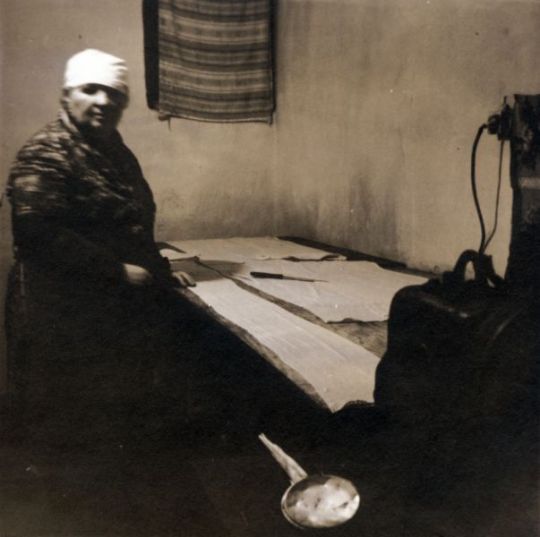
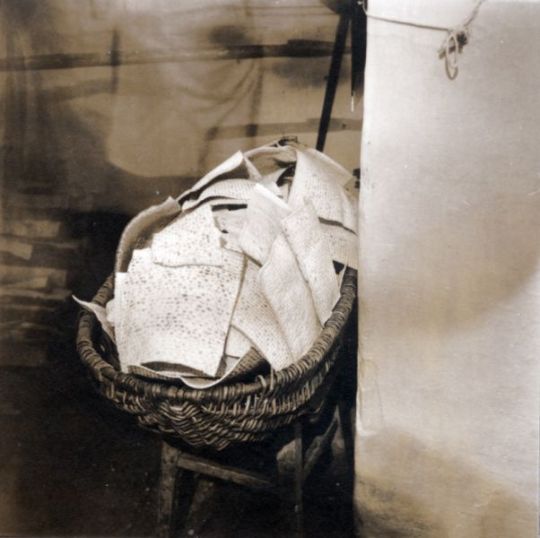
Baking Matzo before Passover, 1992, Tulchin, Ukraine
The Jews were in the 16th century among the first residents of Tulchin. In 1648, the Cossacks conquered the town. Hiding in the fortress of Tulchin, the Poles betrayed the Jews to the Cossacks after fighting them together, but were in turn massacred by their common enemy - a historical event which was the subject of many plays and novels. The number of Jews in Tulchin increased during the 19th century, and with 10,055 Jews in 1897, they formed 62% of the total population. After the German occupation of Ukraine in World War II, Tulchin was incorporated into the region of Transnistria, which had been handed over to Romania. During the autumn of 1941 all Jews of Tulchin were transferred to the camp of Peciora. In general, more Jews survived in the Romanian-occupied zones than in other parts of Ukraine - in 1959 there were still about 2,500 Jews in Tulchin (21% of the total population). The last synagogue was closed by the Soviet authorities in the 1960s. But Tulchin remained one of the few Ukrainian towns with a quite decent post war Jewish community. Jeffrey Veidlinger, author of "In the Shadow of the Shtetl", reports that in 2002, there were 262 Jewish residents, most of them elderly, still living in Tulchin.
186 notes
·
View notes
Text

Just a colored sketch page for now, no rendering. Russian dragons. Not up to scale (don’t trust that visual on the right)
Of these, only the Russian Gray and Ironwing are named in the book (The Gray only in LoD). Both the Ironwing and Cossack dragon didn’t come with descriptions of any sort so I just winged it. Thoughts under the cut.
Russian Heavyweight - Big, green, and mean. Well, Vosyem was green, so this guy is green. Overlapping plates made me lean more on pangolin scales than thyreophoran but doing all the scales is killing me. I gave it a large nasal boss(I think thats the term?) to resemble the tapir-faced depictions of Zmei that had enraptured me since I was young.
The tortoise resemblance was not realized until after I colored everything, but theres only so many ways for long neck and humped back and thick rolls over shoulders read to me. Well, there’s the sauropod type but I prefer a more sprawling pose. I do want it a bit longer but I just like long dragons in general. Need to hold back on it. If everything is long then nothing is Long.
Russian Gray - Mostly gray and white with a narrow arrow-shaped head. They were described as stippled with spots of gray and black. I had on my notes that it was six to seven, but I lacked context on whether it was the number of individuals in the scene or its weight.
Heads being described as arrow shaped confuse me a little. Maybe my English is not good because I keep thinking it’s like… diplocaulus, which is NOT narrow. Yu-Lung, described with the same head shape, was also described to be vulpine, so that’s what I did here.
Russian Black - One of the other lightweights held in the Russian grounds along with the Russian Gray. Described as black dragons smaller than the Grays. Resembles the Russian couriers. Nothing much to say. Slavic dragons seem to be depicted with a crown every so often, so I gave it a crown of small horns.
Every time there’s a black dragon breed from Europe I keep remembering Laurence saying something about how there’s no black dragons known in Europe back when he was still a Naval captain.
Courier - Two red courier dragons were snoozing next to a flag. I’m inclined to think it’s a Russian breed, but it described the flag they were sleeping beside as white and red. Granted, I’m not really familiar with European history or flags. Maybe it’s a company flag?
Cossack - No description other than being courier weight or fly weight, the size of winchesters. Did you know that the Russian Don, cavalry horses of the Cossack, originated from Russian Steppe horses and Oriental breeds obtained from raids? I gave it a more camelid head, but didn’t want the horse inspiration to be too obvious. Not happy with the coloration just yet.
I kinda wanted it to be slightly bigger for some size variety, but it’s unlikely to be that much bigger than the other Russian lightweights. In the British (European?) weight system a flyweight is barely combat weight, isn’t it? So larger than courier weight but not that much…
Ironwing - Venomous. Thats it for textual description. Not much to go off of, so I put a lesser version of the heavyweight armor on it to help bridge the heavyweight to the others and slapped rusty iron colors. I wanted to give it some more resemblance(Is that the word?)for being an ancestor of the Longwing, so I gave it some familiar wing markings. Might add bone spurs but maybe I should keep that a sharpspitter thing.
#temeraire#dragons#sketches#hmd russian dragons#russian gray#hmd ironwing#literally no other breed is named so just a gen russian dragon tag for them#I’m suffering theres an idea I wanted to finish but drawing bridge is beating me up#and trying to conceptualize an irrigation system#I have bitten off more than I can chew#if anyone wants to request a dragon for me to try my hand on I appreciate any distraction coming my way
78 notes
·
View notes
Text
Joachim Murats descendants in the (Great War) World war 1
1. Louis Napoléon Achille Charles Murat (1872-1943)

A vivid figure from a family known for its colorful characters, Louis Napoléon Achille Charles Murat was the great-grandson of Joachim Murat, King of Naples. He began his military career in the French Army, serving from 1891 to 1903 and rising to the rank of lieutenant in the 9th Régiment de Cuirassiers (Heavy Cavalry) stationed in Noyon.
With maternal roots in Mingrelia (present-day Georgia), Murat’s path took a dramatic turn when he joined the Russian Imperial Army during the Russo-Japanese War. Following the Russian defeat, he remained in service, riding with the Kuban Cossack Regiment from 1905 to 1909, and later serving on the staff of Grand Duke Nicholas Nikolaevich until 1911.
At the outbreak of World War I, Murat was in Argentina. Upon learning of the war’s declaration, he returned to Russia and was assigned to several general staffs. By 1917, he was fighting as a colonel in the 12th Starodubovsk Dragoons. During the Russian Revolution, he joined the White Army, continuing to fight in the Carpathians.
After the civil war, Murat returned to France in 1921, where he made a modest living as a translator. In recognition of his service, he was named a Chevalier (Knight) of the Legion of Honor in 1928. He proudly continued to claim his Russian decorations, including the Orders of Saint Vladimir and Saint George, adorned “with all possible swords and citations.”
He passed away in Nice on June 14, 1943,
2. Alexandre Murat (1889–1926)

Alexandre served as a French artillery officer and a direct descendant of the King of Naples. During World War I, he served as a battery commander and was cited for distinction in combat. His commendation praised him for “obtaining from his battery an excellent performance through the precision of fire which he always directed personally from the most exposed observation posts,” and for maintaining morale and discipline “through his calm demeanor and disregard for danger, even amid heavy losses.”
He was one of eight children of Prince Murat who served in the Great War. Among them, Louis Murat fell at the champ d’honneur (field of honor), and several others were wounded—a remarkable testament to the family’s deep involvement and sacrifice during the conflict.
3.Joachim, 6th Prince Murat (1885-1938)

Joachim began World War I as a cavalry lieutenant. He later commanded the Fort des Sartelles during the Battle of Verdun in 1916, where his exemplary conduct earned him the Croix de Guerre with three citations. Subsequently, he served as an interpreter at the General Headquarters of the Royal Flying Corps, based in Saint-Omer from August 1914 to November 1915. After the war, Murat was elected deputy for the Lot in the 1919 French legislative election and served in the Chamber of Deputies until 1929.
4.Prince Charles Murat (1892–1973):

Cavalryman in the Dardanelles Prince Charles Murat brought the legacy of the Napoleonic cavalry to the battlefields of World War I. Initially serving in the French Army, he was later assigned to the Moroccan Tirailleurs, colonial infantry units known for their fierce combat prowess.
During the Gallipoli campaign in the Dardanelles, Charles fought in brutal close-quarters combat and was wounded in the head. His courage under fire earned him one of France’s highest honors: he was named a Chevalier of the Légion d’Honneur for acts of bravery.
5. Prince Gérôme Murat (1898–1992)

Gérôme took part in numerous operations as a machine gunner with the Salmson, Squadron MF 1, making him an aviator of the Murat family. On February 25, 1918, after an aerial battle over the Vosges, his plane caught fire, forcing him to make an emergency landing. As a result of the incident, he had to have one of his legs amputated.
6. Prince Louis Murat (1896-1916)

A volunteer (registration number 2771/308 - Class 1916), he served as marshal of the houses with the 5th Regiment of Foot Cuirassiers. He went to the front on the night of the 17th to the 18th, in the area of the village of Lihons, on the Santerre plateau in the eastern part of the Somme department, during the Battle of the Somme. He was killed on August 21, 1916, just north of Lihons.
40 notes
·
View notes
Text
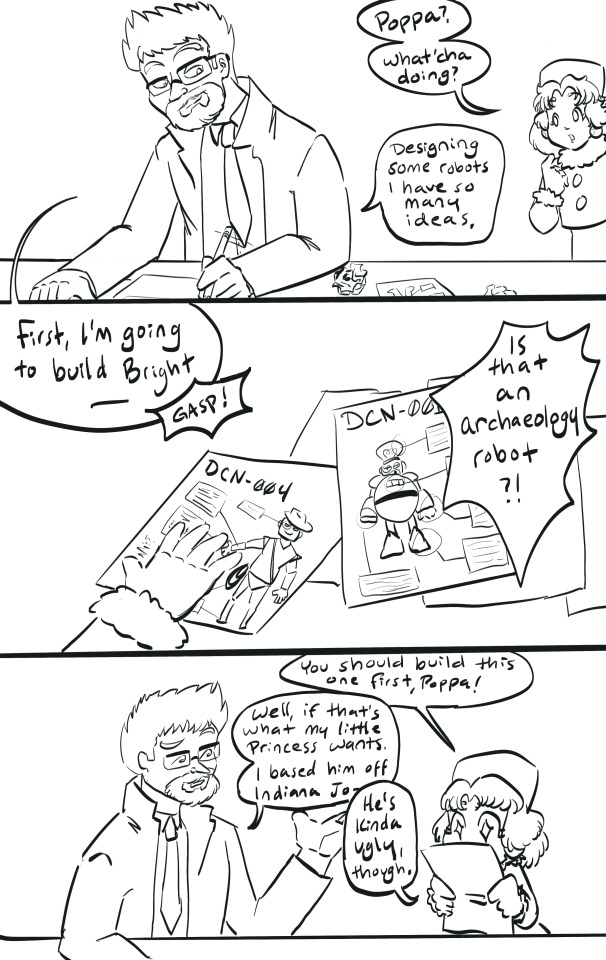

And so Pharaoh Man was born.
There's a fun detail where the Cossack numbers are numbered in order of Bright, Toad, Drill, Pharaoh, Ring, Dust, Dive, Skull, and Tundra.
In the Archie comics however, Pharaoh seems to be the first Cossack bot built, Bright is specifically built after Pharaoh is active, so I like to think this is Kalinka's doing. She definately had an ancient egypt phase.
134 notes
·
View notes
Text
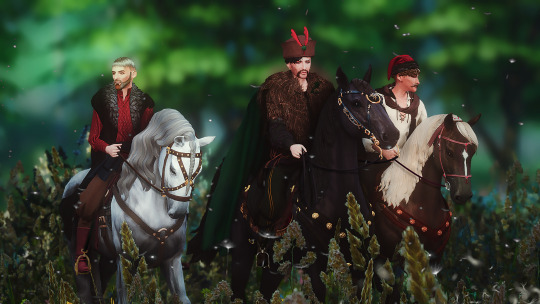


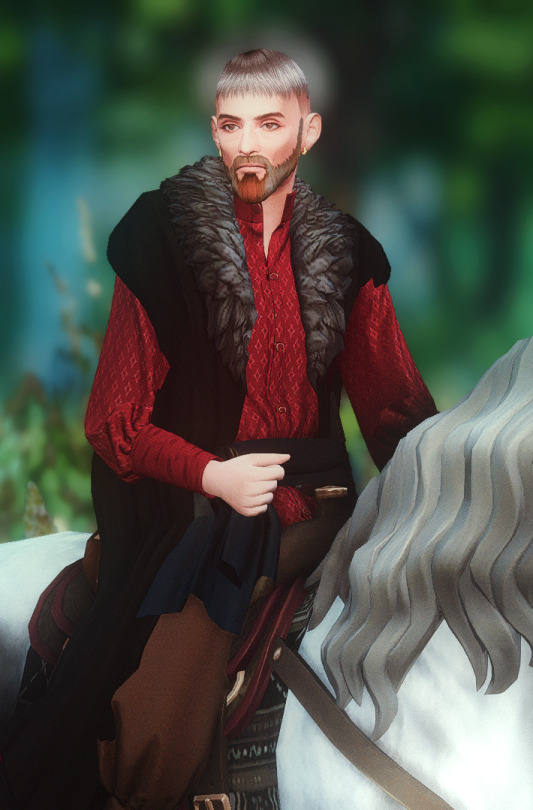
'Lo, there, somewhere near black waters A young cossack mounts his horse. Sadly he parts with his girl, But even more sadly with Ukraine'. Hej Sokoły - Polish/Ukrainian folk song

As a result of today's russian massive attack, near 20 dead and 132 wounded are known. The number of victims continues to rise. It is hard to believe that this story has been going on for centuries...
CC credits: Horses: • SSO Bridle from Khaan Set by @morningstarequestrian • Ancient Rome tack set by @heliossims • Iberian Show Saddle Pad by Zorela • Ornate Saddle Pad by @flowermilksims Cossacks: • Blueboy Lugos outfit by @thesensemedieval • Ye Medieval Leather Boots by Arltos • Colossus Cloak by @lady-moriel • Arthur shirt by @natalia-auditore • Alucard Cloak by Natalia Auditore • Ye Medieval - ARTHUR | top by Plumbobs n Fries • Ye Medieval - ELIAS | pants by Plumbobs n Fries • Ye Medieval Norman Hairstyle by Mazero5 Additional: • Otoman hat edited by me from the Toques hat set by @waxesnostalgic • Kobur hat edited from Santa's hat by me (both have not the best quality so i'm not sure I'll share them)
#sims#the sims 4#sims 4#ts4#simblr#sims historical#sims 4 historical#ts4 historical#17th century#cossacks#ukraine#games stuff
195 notes
·
View notes
Text
here's a jewish joke for you:
I thought I would just make a real quick list of all the pogroms over the past 200 years.
that's it , that's the joke.
it is to laugh.
first of all, I didn't fully understand what a pogrom was until I started making a list.
a pogrom is basically mob violence against the Jews, or in some definitions, mob violence by one community against another. but like. it's when a violent, angry mob smashes, burns, and loots its way through a Jewish neighborhood. this usually involves Jewish casualties.
sometimes the casualties are the point. in the one I just read about, the head of the Cossack brigade crushed a Bolshevik coup in his city, then turned around and told his troops that the Jews were behind it (the Jews had in fact said NO, DON'T, THIS IS A BAD IDEA), and that they were the greatest threat to both Russia and Ukraine, and to "exterminate" them.
and then the troops spent three hours busting into Jewish homes and killing a total of 1,650 people.
wait, no, that's not even my point.
my point is:
i already had more than 190 listed, and tons more places to check or to finish looking at. like, honestly, most of the world and era to finish looking at.
then i got to the Russian Civil War and oopsie
1,326 pogroms.
NO WAIT FUCK
the article it links to says "over 1,500."
like, it's not like i'm gonna put the time in to identify every single one of those. that is just a literally jaw-dropping number of pogroms.
IN tHREE YEARS.
Historians have begun calling it the precursor to the Holocaust.
About 250,000 Jews were killed. 50,000 to 300,000 children were orphaned. And 500,000 were driven out from or fled their homes.
This was AFTER the Soviet Union displaced 600,000 Polish Jews deep into Russia during WWI. It deported 250,000 Polish Jews, and 350,000 more followed as refugees.
52 notes
·
View notes
Text
A number of items belonging to the Botkin family are being auctioned by Coutau-Begarie & Associates. The items are part of the ‘Nobility & Royalty: Imperial Russia - Historical Reminisces of the Russian Imperial Family During their Captivity in Tobolsk from the Botkin Family’ collection and will be auctioned on Thursday 15 May 2025 from 11am onwards.
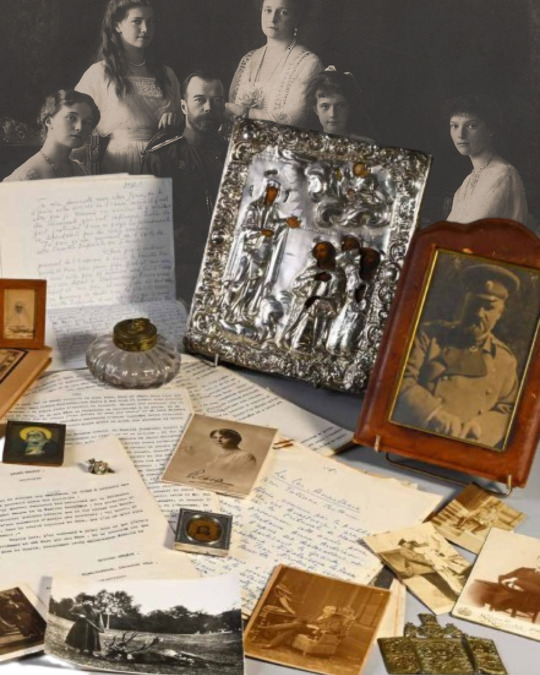
Dr. Evgeny Sergeievich Botkin (often translated as Eugene) was the faithful doctor to the Imperial Family, voluntarily following them into exile in Tobolsk and Ekaterinburg, where he was murdered alongside them on the night of 16/17 July 1918, aged 53. He had four children: Dmitri Evgenievich, Yuri Evgenievich, Gleb Evgenievich, and Tatiana Evgenievna. The youngest, Gleb and Tatiana, were acquaintances of the Romanov children, and are occasionally mentioned in the Grand Duchesses’ diaries. The pair accompanied their father to Tobolsk. Gleb was a talented artist and illustrated stories for the royal children in Tobolsk, which would then be passed to them in the Governor’s House. The children were separated from their father when they were refused safe travel to Ekaterinburg. Fleeing to France, they later became supporters of Franziska Schanzkowska ‘Anna Anderson’
The catalogue of the Botkin’s items being auctioned stretch to 29 pages. I shall make individual posts on notable items later. For now, here is an overview of the items being auctioned:
169 - A portrait of Dr. Sergei Petrovich Botkin, Dr Botkin’s father
170 - A portrait of Dr E.S. Botkin
171 - A photograph of Dr. E.S. Botkin on the Shtandart Yacht
172 - A photograph of Dr. E.S. Botkin at Livadia Palace
173 - A photograph of Dr. E.S. Botkin circa 1917-1918, preserved in a leather frame
174 - An inkwell used by Dr. E.S. Botkin in Tobolsk
175 - A signed telegram sent by Dr. E.S. Botkin during the Russo-Japanese War
176 - A small inkwell used by Dr. E.S. Botkin in Tobolsk
177 - A collection of 28 photographs of the Botkin family
178 - Cufflinks
179 - Jubilee medal of the Corps de Pages, given to Dmitri Botkin
180 - Commemorative medal of the Moscow Orphanage depicting Catherine the Great
181 - Two portrait medallions with engravings of Nicholas II and Alexandra Feodorovna
182 - Portraits on ivory of Nicholas II and Alexandra Feodorovna
183 - Portrait of botanist Mikhail Stepanovich Voronin belonging to Dr. E.S. Botkin’s father
184 - Portrait of a woman and a Cossack
185 - Icon of the Holy Virgin
186 - A portrait of Alexandra Feodorovna with Tatiana Nikolaevna in 1897 (wrongly labelled as being a photo of Alexandra Feodorovna with Alexei Nikolaevich in 1904) from the photograph studio CE Von Hahn and Co
187 - Five postcards of the Romanov family
188 - Four photographs of the Romanov family
189 - Signed photographs of Olga Nikolaevna and Tatiana Nikolaevna in a wooden frame — NOTE: These photographs are exceptionally rare, I have never seen them before
190 - Watercolour painting by Maria Nikolaevna on a letter from Yuri Botkin
191 - Watercolour painting by Maria Nikolaevna on a letter from Yuri Botkin
192 - Eight chapters of Tatiana Melnik-Botkina’s Memories of the Imperial Family Before and After the Revolution written in 1919, two years before publication
193 - 1921 edition of Tatiana Melnik-Botkina’s Memories of the Imperial Family Before and After the Revolution
194 - Typescript of Tatiana Melnik-Botkina’s Memories of the Imperial Family Before and After the Revolution
195 - Short story written in French by Tatiana Melnik-Botkina in 1959, never published
196 - A set of three books: Souvenirs de Russie by Princess Paley, My Father Grigori Rasputin: Memories and Notes by Matryona Rasputin, and Rasputin, the Scoundrel Mong by William Le Queux
197 - Small cigarette case, “made in exile by the officer in service of the Grand Duchess Anastasia Nikolaevna” - likely actually referring to ****Franziska Schanzkowska - signed by S. Kolesnikov
198 - Carved letter opener with Russian church decoration, made by S. Kolesnikov
199 - Carved letter opener with bear head decoration, gift from Nicolas Sedov
200 - Small inkwell used by Tatiana Melnik-Botkina
201 - Handwritten account entitled The Anastasia Case by Tatiana Melnik-Botkina
202 - Typed and handwritten account by Tatiana Melnik-Botkina of a meeting with Franziska Schanzkowska, ‘Anna Anderson’
203 - Handwritten account with letter by Tatiana Melnik-Botkina of a meeting with Franziska Schanzkowska, ‘Anna Anderson’
204 - Autographed letter, papers, and miraculous medal sent to a journalist by Tatiana Melnik-Botkina describing ‘details on Anastasia’ about Franziska Schanzkowska, ‘Anna Anderson’
205 - 33 page autobiographical writing by Tatiana Melnik-Botkina
206 - Eleven official/legal papers belonging to Tatiana Melnik-Botkina
207 - Carving based on Baba Yaga
208 - Detailed box for playing cards
209 - Detailed sewing box
210 - Large wooden Easter egg decorated with the double-headed eagle of the Imperial House of Russia
211 - Set of four wooden Easter eggs, including matryoshkas
212 - Imperial manufactured porcelain Easter egg
213 - Porcelain teacup
214 - Paris porcelain vase in Empire style
215 - Silver boot-puller/bootjack
216 - Silver-plated metal boot-puller/bootjack
217 - Miraculous Icon of the Holy Mother of God Bogolioubovo or the Apparition of the Virgin Mary to Andre Bogolioubsky, a family icon taken by Dr. E.S. Botkin to Tobolsk
218 - Icon of the Holy Mother of God surrounded by two protective Archangels
219 - Travel Triptych Icon representing Saint Nicholas, offered by a patient from Tobolsk to Dr E.S. Botkin, who cared Tobolsk citizens whilst in exile
220 - Icon of Saint Seraphim of Sarov, which Tatiana Melnik-Botkina recalls was given to her by Tsarina Alexandra Feodorovna — Note: an important Saint to the Imperial Family, who was canonised by Nicholas II
221 - Icon of Christ Pantocrator
222 - Icon of the Face of Christ or the Mandylion, given to Dr. E.S. Botkin when his daughter Tatiana fell ill in 1912. From Tatiana Melnik-Botkina’s memoirs: The Empress sent me a bottle of holy water, the Grand Duchess Tatiana, a large bouquet of beautiful flowers, and just as my father was about to leave the Shtandart, the Tsarevich rushed up on deck and shouted ‘Give my regards to Tania! on my behalf!’”
223 - Icon of Saint John Metropolitan of Tobolsk with prayer written on the reverse. Given to Tsarina Alexandra Feodorovna by the Convent of Saint Ivan of Tobolsk upon the family’s arrival in Tobolsk, which was then given to Dr. E.S. Botkin with instruction to give it to Tatiana Melnik-Botkina before their departure to Ekaterinburg
224 - Icon of the Holy Martyr, Varvara
225 - Icon of the Holy Virgin of Kazan
226 - Icon of the Holy Virgin of the Passion
227 - Watercolour by Gleb Botkin of two anthropomorphic horses, dated 1913
228 - Watercolour by Gleb Botkin of an anthropomorphic horse and donkey, dated 1913
229 - Watercolour by Gleb Botkin of an anthropomorphic horse and donkey, undated
230 - Watercolour by Gleb Botkin of an anthropomorphic cat reading a newspaper, dated 1913
231 - Watercolour by Gleb Botkin of an anthropomorphic cat and mouse “with a haircut like Napoleon”, undated
232 - Watercolour by Gleb Botkin of anthropomorphic mice reading by the fireside, dated 1915
233 - Front page of the Krylov novel painted in watercolour by Gleb Botkin, featuring a landscape and an owl, circa 1916-1917
234 - A watercolour by Gleb Botkin of the anthropomorphic animal characters in his illustrated book, The Adventures of Mishka Pushkovich Toptiginsky, created for the Tsar’s children, circa 1916
235 - Teddy bear owned by several generations of Botkin children, originally owned by Gleb Botkin
236 - A watercolour by Gleb Botkin of the anthropomorphic animal characters in his illustrated book, The Adventures of Mishka Pushkovich Toptiginsky, created for the Tsar’s children, dated 1916
237 - A watercolour by Gleb Botkin of the anthropomorphic animal characters staging a revolution in his illustrated book, The Adventures of Mishka Pushkovich Toptiginsky, created for the Tsar’s children, dated 1916
238 - Front page of the Krylov novel painted in watercolour by Gleb Botkin, circa 1916
239 - A watercolour by Gleb Botkin of two anthropomorphic bears for his story The Kingdom of the Bears on the Planet of Mars Inhabited by Animals, circa 1916-1917
240 - A watercolour by Gleb Botkin entitled The Fox and the Mushik, dated 1915, with the story on the back
241 - A watercolour by Gleb Botkin of two of his anthropomorphic bear characters sailing, circa 1916-1917
The next items are included in the same section as the Botkin family items, but seem to have a separate provenance
242 - Portrait of Grand Duchess Maria Feodorovna (later Empress), after Dmitri Levitsky
243 - Portrait of Emperor Alexander II of Russia, engraving and watercolour
244 - Portrait of Grand Duchess Kyra of Russia by Julie Grandhomme-Nozal, in charcoal and gouache
245 - Portrait of Grand Duke Alexander Mikhailovich with a portrait of his son, Prince Feodor Alexandrovich on the reverse by Nicholas Paganiotti Zarokilli, sanguine on paper — NOTE: The birth dates have been mixed up here as the catalogue states that Alexander was born in 1895 and Feodor was born in 1858. In reality, Alexander was born in 1866 and Feodor was born in 1898
246 - Large postal envelope sent to the Imperial Court following the death of Tsar Alexander III with mourning border and seal, sent by Grand Duke Mikhail Mikhailovich
247 - Coloured lithograph depicting Grand Duke Vladimir Alexandrovich and the Duke of Morny
248 - Signed lithograph of Grand Duke Vladimir Alexadrovich
SOURCES
📌Coutau-Bégarie & Associés, Noblesse & Royauté: Russie Impériale, (Paris: Coutau-Bégarie, 2025)
14 notes
·
View notes
Text
by Simon Sebag Montefiore
There is a myth that the last antisemitic pogrom in the British Isles was in medieval York. It was far more recent than that: The long-forgotten Limerick pogrom happened in 1904. It began with a sermon given by a priest and gathered momentum because it was backed by Arthur Griffith, the founder of the original Sinn Féin and friend of Michael Collins.
The story of the Limerick pogrom (or “boycott,” as it is also known) has a special resonance for me because my grandfather and his family, the Jaffes, lived in Limerick then—though they never mentioned it. Indeed, Irish Jewry, including its most famous son, Chaim Herzog, late president of Israel, had protested that Ireland was the most tolerant land in Europe. Now it appears that they protested too much. The strangest thing of all is that the Jews of today’s Ireland are still frightened of telling this story. When I made a television film about the pogrom, most Irish Jews were too scared of “making trouble, attracting attention” to take part in it.
I had always been proud of my Irish roots. My late grandfather, Henry Jaffe, who lost his Irish accent but kept his debonair Irish charm, used to say that he had seen mermaids at Ballybunion, and Aunt Rose used to reminisce in an Irish brogue about the Limerick Races. While talking to a distinguished Irish political writer, I mentioned that I was descended from Limerick Jews. He told me the story that became the basis of my film about the origins of Sinn Féin.
Virtually the whole Jewish community in Limerick, numbering about 170, were from the village of Akmenė in the Tsar’s Baltic territories, which are now Lithuania—part of the Pale of Settlement, the only area where Jews were allowed to live. When in the 1880s Nicholas II stepped up his anti-Jewish legislation, my great-great-grandfather Benjamin Jaffe and most of Akmenė decided to leave before the Cossacks returned. Benjamin bought a ticket for New York, but when he arrived at the picturesque imperial British port of Queenstown in southern Ireland (now called Cobh, whence the Titanic departed on its final voyage), he was told that he had arrived in the New World. “But that doesn’t look like New York,” the Jews protested as they disembarked. “New York’s the next parish,” they were told. When they discovered this was not the case, they settled in Limerick.
They lived together in considerable poverty on Colooney Street, which soon became known as Little Jerusalem. In the 1901 census, four years before the pogrom, my maternal family were registered as peddlers. The patriarch, Benjamin, a magnificent man with a long white beard, was a peddler, though really he was the chazan (singer) and mohel (circumciser) of the little community. He lived at 64 Colooney Street and his son Max, aged 26, lived at Number 31 with his own family, which included my grandfather Henry, aged 3, and my great-aunt Rose, aged 1.
The family has always been proud that Max was a dentist, but I soon discovered that he was not technically qualified; the census called him, alarmingly, “dental mechanic.” It comments dryly that the family could read and write. They must have been the most erudite peddlers who ever existed, for they were as scholarly as they were poor. My grandfather’s bar mitzvah speech is written in both English and in fluent ancient Hebrew, and filled with biblical references.
However hard it was to do business in Limerick, it seemed a safer sanctuary than Russia. But three years after the census, when my grandfather was 6, hatred of this tiny Jewish community reached fever pitch among the very poor Irish to whom they sold their wares. They often sold on credit, and this caused savage resentment. Sometimes when a Jew went to the surrounding countryside to collect a debt, peasant women would pull out their breasts, shout “Rape!,” and then the men would beat up the Jew. An ostentatious Jewish wedding apparently caused jealousy. The pogrom was the result of the increasingly vicious agitation of the spiritual director of Limerick’s Redemptorist Order, Father John Creagh, whose church overshadowed Little Jerusalem. The climax came when Creagh, “a speaker of fervid eloquence,” gave his sermon entitled “How the Israelites trade,” on Monday, January 11, 1904. It reads like a grotesque parody of antisemitism:
The Jews rejected Jesus, they crucified Him and called down the curse of His precious blood on their own heads. . . they did not hesitate to shed Christian blood. Nowadays they dare not kidnap and slay Christian children, but they will not hesitate to expose them to a longer and more cruel martyrdom by taking the clothes off their backs and the bit out of their mouths.
Then Creagh came to the Jews of Limerick:
Twenty years ago and less, Jews were known only by name and evil repute in Limerick. They were sucking the blood of other nations, but those nations turned them out. And they come to our land to fasten themselves like leeches. Their rags have been exchanged for silk. They have wormed themselves into every business. . . the furniture trade, the milk trade, the drapery trade—and they have even traded under Irish names. . . . The victims of the Jews are mostly women. . . .The Jew has a sweet tongue when he wishes. . . . If you want an example, look to France. What is at present going on in that land?
The reference to the Dreyfus scandal is significant.
The injustice of it was little consolation to the Jews of Colooney Street when the thousand or so worshippers of Creagh’s church poured out, as they were to do daily for a month. A huge drunken mob gathered, wielding burning torches. They worked their way down Colooney Street smashing windows and front doors, and forcing their way into the houses which they then looted. For more than a month the Jews of Limerick waited, terrified in their own homes, almost starving, for Creagh had urged the people not to pay their debts. No one would do business with them. If they walked in the streets, they were beaten. The only miracle was that no one lost his life, but for the Jews who had just escaped the Cossacks, it was terrifying.
24 notes
·
View notes
Text
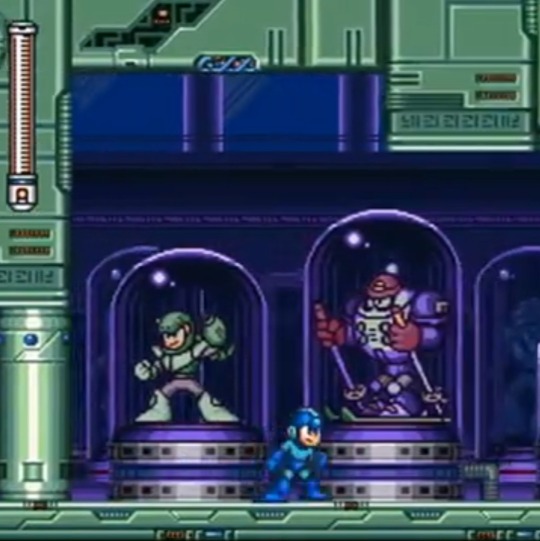
This singular moment is by far the SCARIEST part of the Mega man canon to me.
WHY IS HE IN THERE ALONE? WHY IS HE DEAD!!! WHAT DOES HIS BROTHERS THINK?! WHY ARE THERE SO MANY COSSACK ROBOTS HERE?! ARE THE OTHER ROBOTS JUST ALIVE?
The implications here are terrifying, it sends my toadsnake soul into a deep despair. It breaks my heart into a million pieces to think that he's the FIRST 3RD NUMBER TO BE DEACTIVATED. CANONICALLY(?)
I happily choose to ignore this in my au...robot museums are like graveyards to them.
#snake man#i know all the robots have canonically died by the time the x series started...#but this early?! if snake mans already here then he would never meet any robot after megaman 7#i refuse this#i remain delusional#maybe its just...a replica.#yes and he has a statue there because snake man is so awesome and cool
21 notes
·
View notes
Text

Cossack Idyll (Kozacka idylla)
pencil drawing by Józef Simmler (1823-1868), a Polish painter, draughtsman and cartoonist. Paper on cardboard, 16.2 cm X 13 cm, before 1850.
In the collection of the Polish National Museum in Warsaw (inventory number: Rys.Pol.161476 MNW).
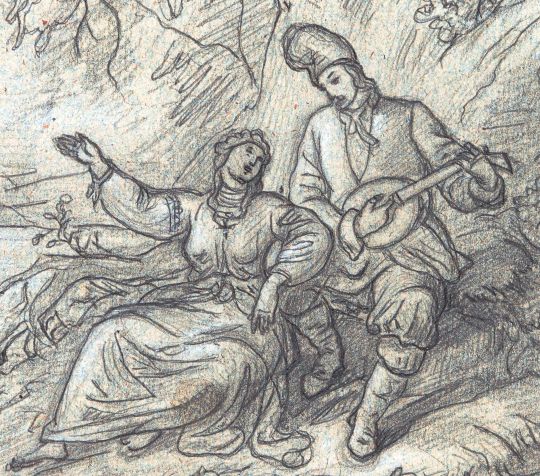
#art#traditional art#polish art#cossack art#cossack heroes#ukrainian cossack#ukrainian cossacks#cossacks#ukrainian history#pencil art#pencil drawing#19th century art
42 notes
·
View notes